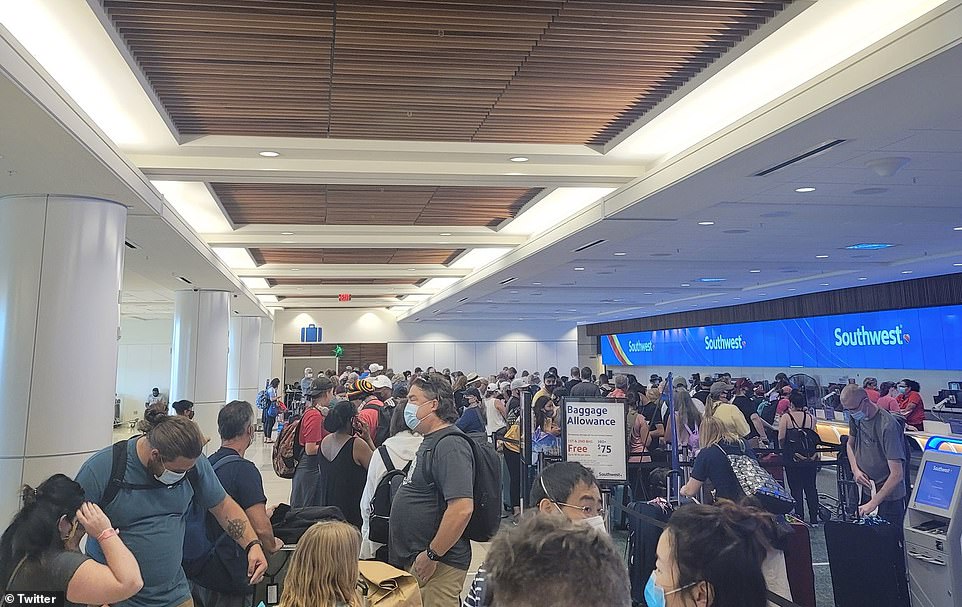By Batya Ungar-Sargon
Southwest Airlines cancelled over 1,000 flights this weekend. Thousands of passengers were left stranded in airports across the country on Sunday, after a quarter of all flights never took off. Southwest blamed air traffic control issues for the cancelations, but to many, they seemed connected to Southwest’s new COVID-19 vaccine mandate, which its pilots asked a court to block. Were the canceled flights the result of a “sick out” on the part of pilots refusing to get vaccinated? The pilots’ union denied it, but when Amtrak started canceling trains Sunday afternoon due to “unforeseen crew issues,” the idea that a general strike is brewing started to circulate, a response to the mass firings of other working-class and middle class Americans—nurses and police officers—who have refused the vaccine.
Trains 465 and 416 departing on 10/10 are canceled due to unforeseen crew issues. Alternate transportation will be provided.— Amtrak Northeast (@AmtrakNECAlerts) October 10, 2021
You might have expected that the Left would be championing what looks like it might be a powerful form of collective action on the part of working-class Americans. There was a time some can still recall when the Left stood for labor and collective power. Instead, you saw prominent Left-wing voices denouncing Southwest employees as terrorists and demanding they be put on no-fly lists; many others defended the mass firing of nurses and cops. And it was Republicans and conservatives, infamous for their laissez-faire free market policies that favor the rich, who were cheering the striking workers and tweeting the hashtag #GeneralStrike.
This inversion of the politics that ruled the U.S. for much of the 20th century didn’t happen overnight. Most recently, it’s an extension of the COVID lockdown class divide that separated those who could work from the safety of their homes—accountants and bankers and lawyers and project managers and, yes, journalists—from those whose jobs required they brave the pandemic to support their families—grocery store workers, deliverymen and women, drivers, pilots, small business owners, and of course, healthcare workers. This was a class divide as much as an economic divide—the college educated vs. the working class. And you can see where each side of the political aisle sees its base by which position it took on this divide: Democrats favored lockdowns while Republicans took the side of those whose work was either outside the home or eliminated.
We now know how this story ended: with conservatives cheering collective action and liberals who stood at the windows of their home offices clapping nurses for putting their lives on the line now championing companies firing them for refusing the vaccine. Never mind that they might have antibodies. Never mind that they know how to keep themselves from getting COVID-19 and how to keep it from spreading, lessons learned in the most dangerous, COVID-infested places while liberals were safely quarantined. Never mind that Black Americans are the least likely to get vaccinated and are now facing exclusion from dining out and going to the movies and expulsion from jobs—jobs they worked when it was the most dangerous to do so (there was a Black Lives Matter protest against vaccine mandates last month).
But this divide didn’t start with the pandemic. It’s been a long time in the making. And it’s not even a purely American phenomenon. French economist Thomas Piketty has documented a massive shift in Western democracies across the globe since the 1960s, in which liberal political parties have lost their working-class base to become parties made up of and catering to the highly educated. Thus, in 1980, the Democrats won just 24 of the 100 counties where people are most likely to have a college degree; the Republicans took 76 of them. In 2020, Trump won a mere 16; Biden took 84 of them.
It’s not just about education, though. The Democrats’ new highly educated base is also increasingly affluent. The Democrats won just nine out of the 100 highest-income counties in 1980; by 2020, Biden won over half of them. The class divide has even led to minority groups increasingly voting for Republicans, a change that’s been driven almost entirely by working-class members of those communities.
For a long time, the attrition of working-class voters to the Republican Party was read as a success of the culture wars. In his 2005 bestseller What’s the Matter with Kansas, Thomas Frank famously argued that the white working class were voting for free-market Republicans because conservatives had whipped them into a state of agitation with a culture war so devious it convinced them to abandon their economic interests. The truth is a little more complicated: With the Democrats taking the lead on globalization, both parties had abandoned the working class economically; at least Republicans didn’t sneer at their values while doing so.
As liberal elites came to define the culture of institutions like the media and the corporate culture of everything from Nike to American Express, conservative institutions like Fox News and Republican politicians could get away with sticking with culture war issues; it was enough not to insult the worldview and values of working-class Americans, who tend to be more conservative on a host of issues.
Read More From The PatriotAmerican
But what we’re seeing now is the possibility that the American working class is developing a class consciousness that’s populist economically, too, albeit in its own way. Forced to defend their autonomy in the face of vaccine mandates, working-class Americans across industries are fighting back and insisting on their collective power. And while they may not pick the issues today’s highly educated Left might wish they did, this moment is presenting Democrats with a stark choice: Do they want to be the side sneering at working-class Americans and cheering at the companies who are firing them? Or do they want to be the side that stands for their empowerment and autonomy, however they themselves choose to define it?

